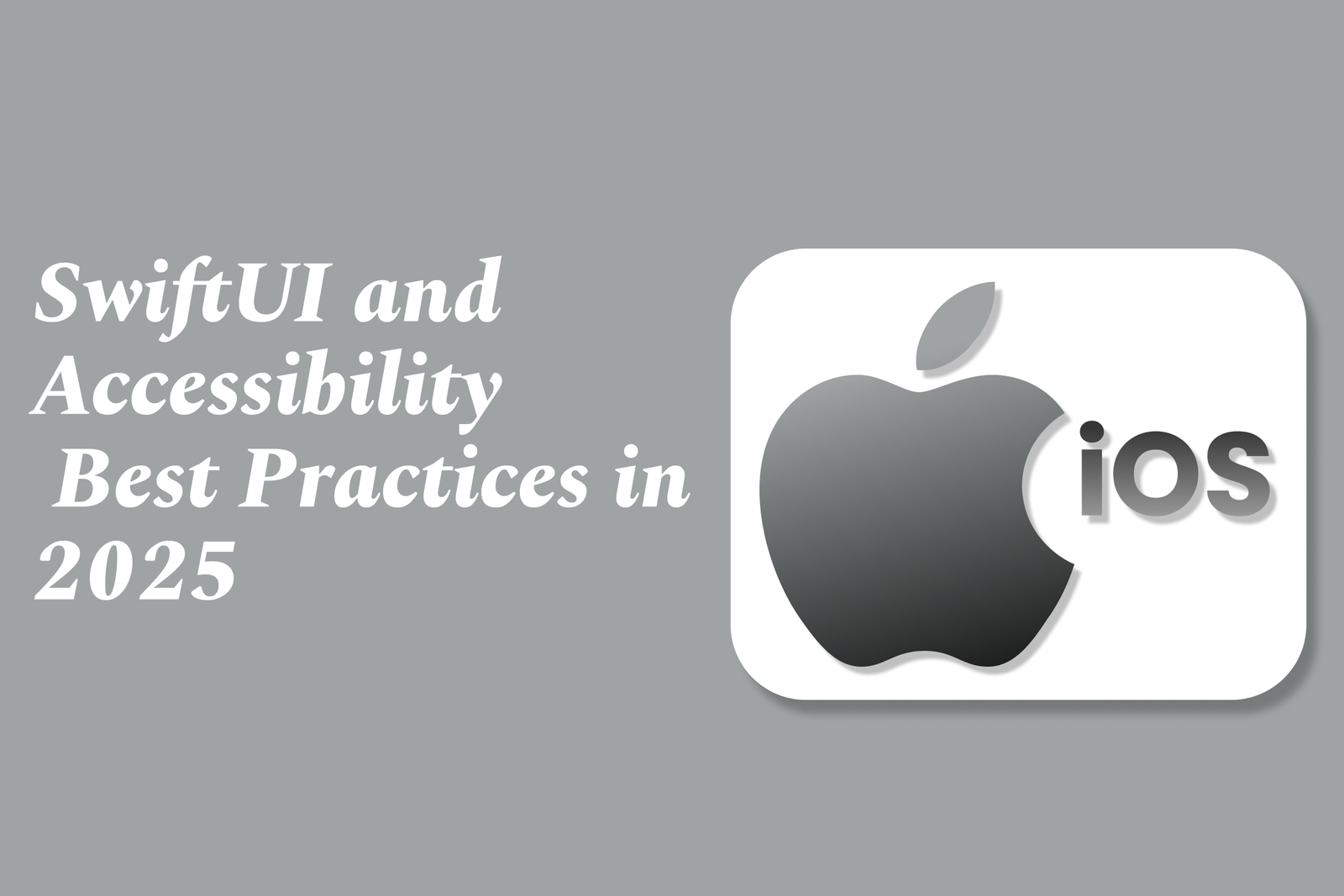SwiftUI and accessibility: Best practices in 2025
SwiftUI in 2025 empowers developers to build inclusive apps with declarative syntax, native support for accessibility features, dynamic type, and customizable animations. Best practices emphasize clear labels, semantic grouping, testing, and respecting user preferences for an optimal accessible experience.
SwiftUI and Accessibility: Best Practices in 2025
1 ) Understanding SwiftUI's Accessibility Foundations
SwiftUI is Apple's declarative UI framework enabling developers to create beautiful, consistent, and responsive apps across Apple platforms with minimal code. Since accessibility is integral to great app experiences, SwiftUI incorporates built in support that developers can leverage to build inclusive applications from the ground up.
2 ) Declarative Syntax and Accessibility
SwiftUI uses a declarative syntax that allows developers to describe the UI structure clearly, making it easier to include accessibility attributes. For instance, developers can attach accessibility modifiers directly to views, specifying labels, hints, and traits that voice over and assistive technologies use. This clear syntax facilitates maintaining and updating accessibility features as the app evolves.
3 ) Animating with Accessibility Considerations
SwiftUI simplifies animations, making it easier to add dynamic behavior without complex code. However, in 2025 best practices emphasize ensuring animations do not interfere with accessibility — such as enabling reduced motion preferences and providing alternatives for animations that might trigger vestibular disorders or distract users with cognitive disabilities.
4 ) Supporting Dynamic Type and Color Schemes
SwiftUI inherently supports Dynamic Type, scaling fonts based on user settings for readability. Additionally, SwiftUI adapts seamlessly to system dark and light modes. Developers should verify that custom color schemes and UI elements maintain adequate contrast and readability under all display modes to comply with WCAG 2.1 and beyond.
5 ) Leveraging New Accessibility APIs and Features
In 2025, SwiftUI integrates with the latest accessibility APIs, including detailed control over accessibility focus, custom rotor support for easier navigation, and improved semantic grouping of UI elements. Developers are encouraged to use these APIs to provide richer, more navigable interfaces that accommodate different disabilities.
6 ) Testing and Validation are Crucial
Automated tools and manual testing remain essential for ensuring accessibility compliance. Developers should utilize Xcode's Accessibility Inspector, VoiceOver testing, and external audit tools aligned with the 2025 Web Content Accessibility Guidelines (WCAG 2.1 and upcoming updates). Early testing in the development cycle helps identify barriers before release.
7 ) Inclusive Design Beyond Compliance
Accessibility in SwiftUI is not just about meeting legal requirements but about creating experiences usable and enjoyable by everyone. Best practices in 2025 include designing for cognitive and learning disabilities, providing clear content structure, meaningful labels, and ensuring interactive elements are easily discoverable and operable.
8 ) Continuous Education and Community Resources
The SwiftUI and accessibility landscape continues to evolve. Developers should engage with community resources, tutorials, and courses, staying updated on best practices. Sharing knowledge and challenges fosters a culture committed to building truly accessible digital experiences.
Summary:
SwiftUI empowers developers with powerful, straightforward tools to build accessible apps. Best practices in 2025 focus on leveraging declarative syntax to add semantic accessibility information, ensuring animations respect user preferences, supporting dynamic type and dark mode effectively, utilizing new accessibility APIs for enhanced navigation, rigorous testing for compliance, and embracing inclusive design principles that extend beyond mere standards compliance. Continuous education and community engagement are vital to advancing accessibility efforts within the SwiftUI ecosystem.
https://justacademy.in/news-detail/android-system-permissions-overview
https://justacademy.in/news-detail/flutter-hackathons-&-winners-in-2025
https://justacademy.in/news-detail/performance-testing-in-flutter-4.0
https://justacademy.in/news-detail/how-react-native-is-powering-the-future-of-smart-home-apps
https://justacademy.in/news-detail/swift-concurrency-updates:-what-to-expect
Related Posts
Java supports GDPR and data privacy by enabling secure data handling through encryption, controlled access, and precise data management. It allows developers to minimize PII exposure, ensure data confidentiality, and design workflows that comply with data protection regulations effectively.
Java code quality tools have evolved to include advanced static analysis, integrated security checks, and AI-powered code reviews. These updates help developers detect bugs, enforce coding standards, and enhance security, streamlining the development process and improving overall code reliability.
Java remains a cornerstone in big tech companies, evolving with modern features like records, pattern matching, and virtual threads. Its robust ecosystem, enhanced performance, and growing AI integrations keep it vital for both legacy systems and innovative new projects.
Java and CI/CD pipeline optimizations streamline Java application development by automating builds, tests, and deployments. They improve efficiency through parallelization, caching, and secure secrets management, enabling faster feedback loops and more reliable, scalable software delivery.
Java supports modern cryptography standards through its flexible Java Cryptography Architecture (JCA), enabling integration of advanced algorithms like AES, EdDSA, and post-quantum tools. Libraries like Bouncy Castle offer FIPS-certified, hardware-accelerated implementations for secure development.
Java 23 enhances record patterns by enabling concise, direct destructuring of record components within pattern matching, simplifying type checks and data extraction. This improvement boosts code readability and expressiveness by reducing boilerplate in handling immutable data classes.
Java remains a top choice for mobile app backends, powering scalable, secure, and high-performance server-side solutions. Latest trends include cloud-native microservices, reactive programming, and enhanced JVM optimizations, enabling efficient, flexible, and robust mobile backend development.
Java SE 24 and LTS Java SE 21 offer enhanced features and performance, while Apache Spark 4.0.0 introduces Scala 2.13 support and advanced ML and SQL capabilities. Together, they empower developers to build scalable, high-performance data applications with modern tools.
JUnit 5 modernizes Java testing with a modular architecture, improved assertions, and seamless Java 8+ support. Beyond JUnit, tools like Mockito and AssertJ enhance mocking and assertions, creating a powerful, flexible ecosystem for writing clean, efficient Java unit tests.
Java plays a pivotal role in cloud automation tools by providing a robust, platform-independent language used to build scalable automation frameworks like Jenkins and Selenium, enabling efficient CI/CD pipelines, testing, and orchestration across diverse cloud environments.










